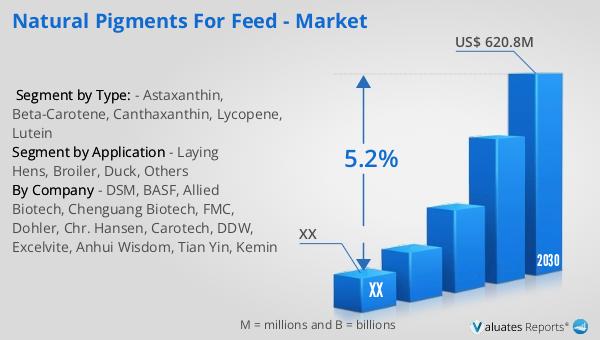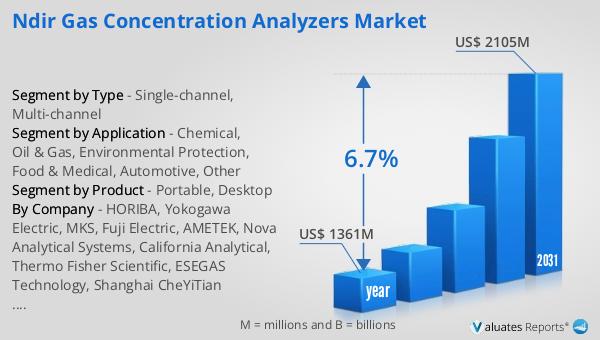What is Natural Pigments for Feed - Global Market?
Natural pigments for feed are naturally occurring substances used to enhance the color of animal feed, which in turn affects the appearance of animal products like eggs, meat, and fish. These pigments are derived from various natural sources such as plants, algae, and microorganisms. They are primarily used in the animal feed industry to improve the aesthetic appeal of products, which can influence consumer preferences and marketability. The global market for natural pigments in feed is driven by the increasing demand for naturally derived additives, as consumers become more health-conscious and environmentally aware. The use of natural pigments is also associated with potential health benefits for animals, including improved growth rates and immune function. As the demand for organic and natural products continues to rise, the market for natural pigments in animal feed is expected to grow, offering opportunities for innovation and development in this sector. The market is characterized by a diverse range of products, each with specific applications and benefits, catering to different segments of the animal feed industry.

Astaxanthin, Beta-Carotene, Canthaxanthin, Lycopene, Lutein in the Natural Pigments for Feed - Global Market:
Astaxanthin, beta-carotene, canthaxanthin, lycopene, and lutein are some of the most commonly used natural pigments in the global feed market. Astaxanthin is a red pigment found in microalgae and yeast, and it is widely used in aquaculture to enhance the pink or red color of fish and shrimp. This pigment is known for its strong antioxidant properties, which can improve the health and growth of aquatic animals. Beta-carotene, an orange pigment found in carrots and other vegetables, is used in poultry feed to enhance the color of egg yolks and chicken skin. It is also a precursor to vitamin A, which is essential for animal health. Canthaxanthin is another red pigment, often used in poultry and fish feed to achieve a deeper red or orange hue. It is known for its stability and effectiveness in coloring animal products. Lycopene, a red pigment found in tomatoes, is used in feed for its antioxidant properties and its ability to enhance the color of animal products. Lutein, a yellow pigment found in marigolds and other plants, is used in poultry feed to enhance the color of egg yolks and chicken skin. It is also known for its potential health benefits, including eye health and immune support. These pigments are valued not only for their coloring properties but also for their potential health benefits for animals, making them an important component of the global feed market.
Laying Hens, Broiler, Duck, Others in the Natural Pigments for Feed - Global Market:
The use of natural pigments in feed is particularly significant in the production of laying hens, broilers, ducks, and other animals. In laying hens, natural pigments like beta-carotene and lutein are used to enhance the color of egg yolks, which is a key quality attribute for consumers. A rich, golden yolk is often associated with higher quality and better taste, making it a desirable trait in the market. For broilers, pigments such as canthaxanthin and beta-carotene are used to improve the color of chicken skin, which can influence consumer preferences and marketability. A well-colored chicken is often perceived as fresher and more appealing, which can lead to higher sales. In ducks, natural pigments are used to enhance the color of the skin and meat, which is important for both aesthetic and culinary reasons. The use of pigments can also improve the overall health and growth of ducks, leading to better production outcomes. In other animals, natural pigments are used to improve the appearance and health of the animals, which can lead to better marketability and consumer acceptance. The use of natural pigments in feed is an important aspect of animal production, as it can influence both the quality and marketability of animal products.
Natural Pigments for Feed - Global Market Outlook:
The global market for natural pigments used in animal feed was valued at approximately $439 million in 2023. This market is projected to grow significantly, reaching an estimated value of $620.8 million by 2030. This growth represents a compound annual growth rate (CAGR) of 5.2% over the forecast period from 2024 to 2030. The increasing demand for natural and organic products, along with the growing awareness of the health benefits associated with natural pigments, is driving this market expansion. As consumers become more conscious of the ingredients in their food and the impact of these ingredients on health and the environment, the demand for naturally derived additives in animal feed is expected to rise. This trend is further supported by the increasing focus on sustainable and environmentally friendly farming practices, which prioritize the use of natural and organic inputs. The market for natural pigments in animal feed is characterized by a diverse range of products, each with specific applications and benefits, catering to different segments of the animal feed industry. This diversity, along with the growing demand for natural products, is expected to drive the growth of the market in the coming years.
| Report Metric | Details |
| Report Name | Natural Pigments for Feed - Market |
| Forecasted market size in 2030 | US$ 620.8 million |
| CAGR | 5.2% |
| Forecasted years | 2024 - 2030 |
| Segment by Type: |
|
| Segment by Application |
|
| By Region |
|
| By Company | DSM, BASF, Allied Biotech, Chenguang Biotech, FMC, Dohler, Chr. Hansen, Carotech, DDW, Excelvite, Anhui Wisdom, Tian Yin, Kemin |
| Forecast units | USD million in value |
| Report coverage | Revenue and volume forecast, company share, competitive landscape, growth factors and trends |
